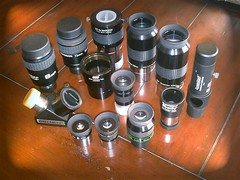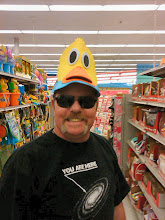

When beginning astronomers start looking at telescopes, one of the least understood aspects of these optical instruments are simple telescope eyepieces. While lenses and mirrors and designs are easy to grasp, the actual eyepiece itself can be somewhat confusing. However, they are vital parts of the telescope, as they provide the final creation and magnification of the telescope image and they are the one part of the telescope that spends its time in almost constant contact with the person using it. All of which means that telescope eyepieces are important considerations when putting together a telescope.
When looking at telescope eyepieces, remember that you are essentially paying for the lenses in the eyepiece. The more an eyepiece costs, the better the lenses inside and the better the image it creates. And, because the rest of the telescope is only as good as the image that reaches the user’s eye, it is well worth the while to invest a little extra in the eyepieces to be used on a good telescope.
It is also good to remember that image quality of telescope eyepieces can be affected by the design of the eyepiece. For instance, Huygens eyepieces can create chromatic aberrations, Erfle eyepieces can produce some ghost images, and Plossl eyepieces tend to have some astigmatism around the edges of the image. So, when choosing eyepieces, it is also a good idea to understand the limits of each design and what sort of work each design is suited to.
Another aspect to consider when choosing telescope eyepieces is the apparent field of view. This is the apparent width of the image, in degrees, which indicates how far a person needs to move their eye in order to look from one end of the image to the other. Essentially, it is a measure of the peripheral vision available to the person looking through the eyepiece. Depending on the design of the telescope eyepiece, the apparent field of view can range from 40 to 82 degrees. Obviously, the narrower fields of view give the feeling of looking down a tunnel, making it more difficult to scan the sky and find objects.
However, the field of view and image clarity are not the only concerns with telescope eyepieces. A major, but often overlooked, trait is that of eye relief. This is the distance between the eye and the actual lens surface and it is vital that people understand its importance. After all, this can affect the person using the telescope by simply making it uncomfortable or difficult to use the telescope. If someone doesn’t have room to wear their glasses when they look through the eyepiece, or their eyelashes rub against the lens, it is simply not worth the effort to use the telescope. And if someone’s eyelashes are rubbing against the lens, it is transferring dust and oils to the lens, degrading the image and, in fact, making the telescope less effective. Of course, the only way to really find the right eye relief is to try out several telescope eyepieces and see which ones feel right.
Overall, telescope eyepieces are best judged through experience, which means that trying out several designs and models is the best way to figure out what works best. But, with a little trial and error, the right telescope eyepieces can make their way into your telescope kit.
When looking at telescope eyepieces, remember that you are essentially paying for the lenses in the eyepiece. The more an eyepiece costs, the better the lenses inside and the better the image it creates. And, because the rest of the telescope is only as good as the image that reaches the user’s eye, it is well worth the while to invest a little extra in the eyepieces to be used on a good telescope.
It is also good to remember that image quality of telescope eyepieces can be affected by the design of the eyepiece. For instance, Huygens eyepieces can create chromatic aberrations, Erfle eyepieces can produce some ghost images, and Plossl eyepieces tend to have some astigmatism around the edges of the image. So, when choosing eyepieces, it is also a good idea to understand the limits of each design and what sort of work each design is suited to.
Another aspect to consider when choosing telescope eyepieces is the apparent field of view. This is the apparent width of the image, in degrees, which indicates how far a person needs to move their eye in order to look from one end of the image to the other. Essentially, it is a measure of the peripheral vision available to the person looking through the eyepiece. Depending on the design of the telescope eyepiece, the apparent field of view can range from 40 to 82 degrees. Obviously, the narrower fields of view give the feeling of looking down a tunnel, making it more difficult to scan the sky and find objects.
However, the field of view and image clarity are not the only concerns with telescope eyepieces. A major, but often overlooked, trait is that of eye relief. This is the distance between the eye and the actual lens surface and it is vital that people understand its importance. After all, this can affect the person using the telescope by simply making it uncomfortable or difficult to use the telescope. If someone doesn’t have room to wear their glasses when they look through the eyepiece, or their eyelashes rub against the lens, it is simply not worth the effort to use the telescope. And if someone’s eyelashes are rubbing against the lens, it is transferring dust and oils to the lens, degrading the image and, in fact, making the telescope less effective. Of course, the only way to really find the right eye relief is to try out several telescope eyepieces and see which ones feel right.
Overall, telescope eyepieces are best judged through experience, which means that trying out several designs and models is the best way to figure out what works best. But, with a little trial and error, the right telescope eyepieces can make their way into your telescope kit.







No comments:
Post a Comment